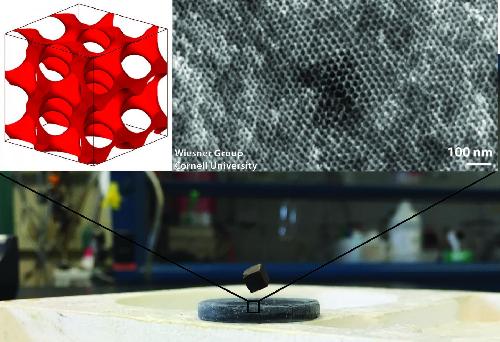ITHACA, N.Y. - Building on nearly two decades' worth of research, a multidisciplinary team at Cornell has blazed a new trail by creating a self-assembled, three-dimensional gyroidal superconductor.
Ulrich Wiesner, a materials science and engineering professor who led the group, says it's the first time a superconductor, in this case niobium nitride (NbN), has self-assembled into a porous, 3-D gyroidal structure. The gyroid is a complex cubic structure based on a surface that divides space into two separate volumes that are interpenetrating and contain various spirals. Pores and the superconducting material have structural dimensions of only around 10 nanometers, which could lead to entirely novel property profiles of superconductors.
Currently, superconductivity for practical uses such as in magnetic resonance imaging (MRI) scanners and fusion reactors is only possible at near absolute zero (-459.67 degrees Fahrenheit), although recent experimentation has yielded superconducting at a comparatively balmy -70 degrees C (-94 degrees F).
 The Wiesner Group at Cornell University has synthesized the first block copolymer self-assembly-derived nanostructured superconductor. Shown is an example of a bismuth-based superconductor levitating a magnet, with simulated and electron microscope images of the nanostructured material. Credit: Cornell University
The Wiesner Group at Cornell University has synthesized the first block copolymer self-assembly-derived nanostructured superconductor. Shown is an example of a bismuth-based superconductor levitating a magnet, with simulated and electron microscope images of the nanostructured material. Credit: Cornell University
"There's this effort in research to get superconducting at higher temperatures, so that you don't have to cool anymore," Wiesner said. "That would revolutionize everything. There's a huge impetus to get that."
Wiesner and his co-author Sol Gruner had been dreaming for over two decades about making a gyroidal superconductor in order to explore how this would affect the superconducting properties. The difficulty was in figuring out a way to synthesize the material. The breakthrough was the decision to use NbN as the superconductor.
Superconductivity, in which electrons flow without resistance and the resultant energy-sapping heat, is still an expensive proposition. MRIs use superconducting magnets, but the magnets constantly have to be cooled, usually with a combination of liquid helium and nitrogen.
Wiesner's group started by using organic block copolymers to structure direct sol-gel niobium oxide (Nb2O5) into three-dimensional alternating gyroid networks by solvent evaporation-induced self-assembly. Simply put, the group built two intertwined gyroidal network structures, then removed one of them by heating in air at 450 degrees.
The team's discovery featured a bit of "serendipity," Wiesner said. In the first attempt to achieve superconductivity, the niobium oxide (under flowing ammonia for conversion to the nitride) was heated to a temperature of 700 degrees. After cooling the material to room temperature, it was determined that superconductivity had not been achieved. The same material was then heated to 850 degrees, cooled and tested, and superconductivity had been achieved.
"We tried going directly to 850, and that didn't work," Wiesner said. "So we had to heat it to 700, cool it and then heat it to 850 and then it worked. Only then."
Wiesner said the group is unable to explain why the heating, cooling and reheating works, but "it's something we're continuing to research," he added.
Limited previous study on mesostructured superconductors was due, in part, to a lack of suitable material for testing. The work by Wiesner's team is a first step toward more research in this area.
"We are saying to the superconducting community, 'Hey, look guys, these organic block copolymer materials can help you generate completely new superconducting structures and composite materials, which may have completely novel properties and transition temperatures. This is worth looking into,'" Wiesner said.
source: Cornell University